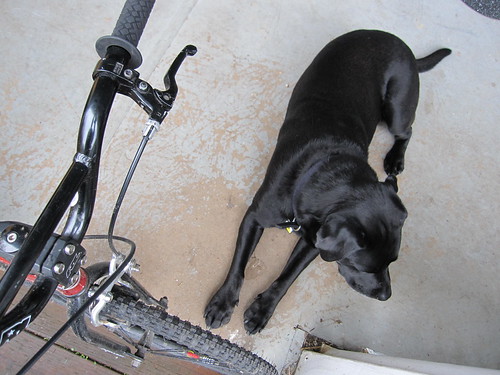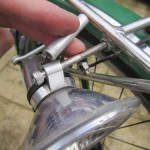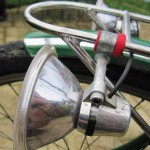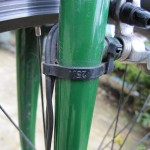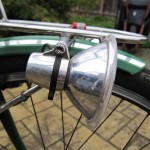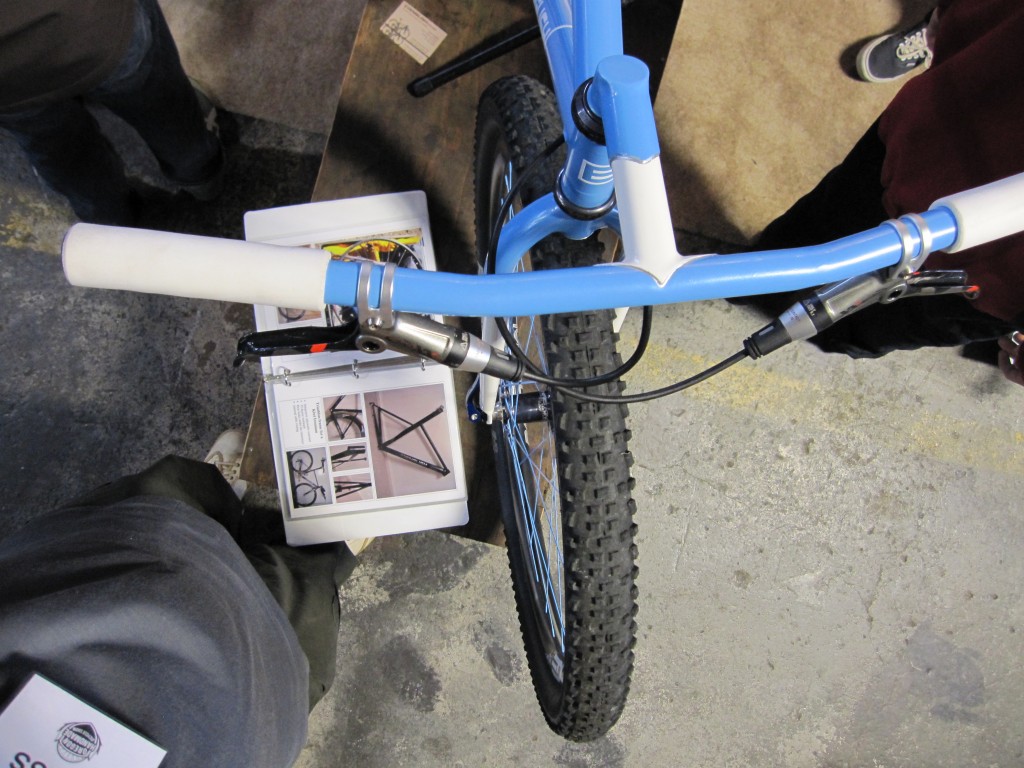 Here’s how to mount two dynamo-driven E6 halogen lights to a Nitto M-12 mini front rack. This older-style M12 has two mounting points, but they’re on the same side – one is for an m5 bolt, the other an m6. The newest version of the M12 has two light mounts, and they’re lower.
Here’s how to mount two dynamo-driven E6 halogen lights to a Nitto M-12 mini front rack. This older-style M12 has two mounting points, but they’re on the same side – one is for an m5 bolt, the other an m6. The newest version of the M12 has two light mounts, and they’re lower.
Mount the lights upside-down
Mounted in the normal way, the lights stick up above the edge of the rack. To keep using the rack to carry things, you have to mount the lights upside-down, BUT 
 when the lenses are upside-down, they have a bad beam pattern.
when the lenses are upside-down, they have a bad beam pattern.
So, you need to turn the lenses over, but you have to modify them a little to do it. There is a large ‘ear’ and a small ‘ear’ on the lens that fit into notches in the light body. Use side-cutters and a nail file to trim the larger ear down so it fits in the smaller notch.
Use long bolts and spacer tubes
You need two 3″ m5 bolts, and about 6″ of aluminum tubing. The tubing at ACE wasn’t all the same, so I used a long m5 bolt to check the fit. Use the snuggest tube that doesn’t bind.

 The right mount goes together easily, and looks legit. Measure and cut a piece of tubing long enough to stand the light off the rack, but engages all the bolt threads in the eyelet. Line up all the holes and tighten it up!
The right mount goes together easily, and looks legit. Measure and cut a piece of tubing long enough to stand the light off the rack, but engages all the bolt threads in the eyelet. Line up all the holes and tighten it up!

 The left mount looks… quaint. Use a stainless P-clamp, an m5 Nylock nut, and about 8″ of cotton bar tape. Remove the rubber from the Adel clip, and put about five wraps of tape on the rack rail. It is a sturdier mount than just the clamp with its rubber sleeve.
The left mount looks… quaint. Use a stainless P-clamp, an m5 Nylock nut, and about 8″ of cotton bar tape. Remove the rubber from the Adel clip, and put about five wraps of tape on the rack rail. It is a sturdier mount than just the clamp with its rubber sleeve.
The left mount is sketchier than the right, but the second light is very nice at speed. I understand that an LED light like the Cyo or Edelux puts out more light than both of these together, so if you’re setting up one of those, just use one bolt and spacer and keep it clean. I plan to replace these two with a single Cyo LED light in the future.
Trim the wires and run them neatly
I hate cluttery cables, which is why I like multi-speed fixed gears.

 Trim the wires to length, and tie them down. I used a plastic cable tie at the top, and copper wire on the fork leg. If you think you’ll ever want to mount your lights on the bar, or sell them to someone with a bigger bike… do something else.
Trim the wires to length, and tie them down. I used a plastic cable tie at the top, and copper wire on the fork leg. If you think you’ll ever want to mount your lights on the bar, or sell them to someone with a bigger bike… do something else.
E6 Rack Mount Picture Gallery:


 Casey and Duncan, originally uploaded by Watson House.
Casey and Duncan, originally uploaded by Watson House.



